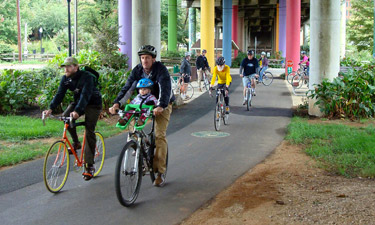 What do park and recreation agencies, community health, and economic development all have in common? Everything—according to park and recreation staff in Montgomery, Alabama; Jackson, Tennessee; and Greenville, South Carolina. Park and recreation agencies have always sought to improve health, providing access to exercise facilities; parks and trails for sports, running, biking, and walking; and pools for swimming. But many of these amenities are only used by a health-conscious minority of citizens. As the obesity epidemic hits more and more communities, park and recreation agencies have become a relevant partner in community-based health initiatives throughout the country, working to improve access to a healthy lifestyle for all residents. Improving the physical infrastructure of a community has helped several communities reap economic benefits as well. Park and recreation agencies have been catalysts for these changes in several communities.
What do park and recreation agencies, community health, and economic development all have in common? Everything—according to park and recreation staff in Montgomery, Alabama; Jackson, Tennessee; and Greenville, South Carolina. Park and recreation agencies have always sought to improve health, providing access to exercise facilities; parks and trails for sports, running, biking, and walking; and pools for swimming. But many of these amenities are only used by a health-conscious minority of citizens. As the obesity epidemic hits more and more communities, park and recreation agencies have become a relevant partner in community-based health initiatives throughout the country, working to improve access to a healthy lifestyle for all residents. Improving the physical infrastructure of a community has helped several communities reap economic benefits as well. Park and recreation agencies have been catalysts for these changes in several communities.
Greenville, South Carolina, has made their Trails and Greenways Master Plan a cornerstone of their economic growth plan. This plan makes consideration of the greenway an explicit part of local planning. By working at the policy level, these changes are more likely to be sustainable and create a cultural norm for health promotion for the city. Trails for visitors and residents are actively marketed as health-promoting human-powered options for transportation. The Greenville County Recreation District has engaged pediatricians in distributing maps of parks and trails to families to increase physical activity for children at risk for obesity. In conjunction with expanded parks and trails, Greenville has adopted a Complete Streets policy, which specifies that future street planning will take into account the transit needs of pedestrians and cyclists in addition to motorists. The pedestrian and bicyclist-friendly downtown Greenway on the River was developed as an anchor for urban revitalization. By investing in active transportation and community health, Greenville intends to be known as one of the healthiest cities in America, attracting new businesses, residents, and tourists.
The mayor of Montgomery, Alabama, was worried that high obesity-related health care costs would deter businesses from relocating to the city. A partnership between parks and recreation, the Regional Planning Commission, and the Department of Public Relations and External Affairs was formed to improve community health with the explicit goal of attracting new businesses to the area. The Montgomery County Parks and Recreation Department was instrumental in implementing bike-friendly roadways, physical activity in afterschool programs, walk-to-school programs, and urban farms to promote Montgomery’s standing as a healthy city. Not only has Montgomery seen their obesity ranking improve in only two years, but the city also has documented an economic dividend from these investments. Local leaders in Jackson, Tennessee, noted that a nearby city with better health statistics and better infrastructure for physical activity was winning more bids for new businesses, and they postulated that new businesses were able to obtain lower health insurance rates in the healthier city. The City of Jackson Recreation and Parks Department quickly mobilized with the Chamber of Commerce, the Department of Public Health, and other local leaders to generate a vibrant farmer’s market, community gardens, mobile produce vendors, a more walkable community, parks with fitness stations, and plans for a new downtown fitness center. The park and recreation department has committed ongoing staff time to community health because it is seen as essential to increasing Jackson’s future competitiveness for economic development.
While the park and recreation agencies in these communities did not accomplish these feats in isolation, they were essential partners in all developments. By broadening their scope to encompass community health, park and recreation departments in these communities have moved beyond “nice but overlooked amenities” to key players in economic development. This more prominent role of park and recreation agencies in the community not only benefits the health of the community, but also helps to ensure the long-term sustainability of park funding within local budgets. Those communities that have broadened their focus took the following steps:
- They actively engaged with other regional stakeholders with an interest in community health.
- They used data to assess community assets and needs for physical activity and nutrition.
- They actively thought past the health- conscious minority. They considered how to move the “interested but sedentary” group into the “active” group.
- They created an action plan with measurable goals to address needs and to be able to show progress.
- They leveraged funds from multiple stakeholders to grow the pot of money available for the work.
- They sought out and engaged in creative local partnerships.
- They conducted joint fundraising with partners.
Erika Lehmann is with Smith and Lehmann Consulting. For more information, contact Zarnaaz Bashir, MPH.

